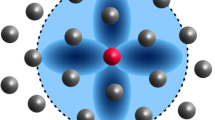Abstract
In this work, the traditional method of potential of mean force (PMF) is improved for describing the protein-protein interactions. This method is developed at atomic level and is distance-dependent. Compared with the traditional method, our model can reasonably consider the effects of the environmental factors. With this modification, we can obtain more reasonable and accurate pair potentials, which are the pre-requisite for precisely describing the protein-protein interactions and can help us to recognize the interaction rules of residues in protein systems. Our method can also be applied to other fields of protein science, e.g., protein fold recognition, structure prediction and prediction of thermostability.
Similar content being viewed by others
References
Sippl M J. Knowledge-based potentials for proteins. Curr Opin Struct Biol, 1995, 5: 229–235
Jernigan R L, Bahar I. Structure-derived potentials and protein simulations. Curr Opin Struct Biol, 1996, 6: 195–209
Jones D T, Thornton J M. Potential energy functions for threading. Curr Opin Struct Biol, 1996, 6: 210–216
Vajda S, Sippl M J, Novotny J. Empirical potentials and functions for protein folding and binding. Curr Opin Struct Biol, 1997, 7: 222–228
Moult J. Comparison of database potentials and molecular mechanics force fields. Curr Opin Struct Biol, 1997, 7: 194–199
Lazaridis T, Karplus M. Effective energy functions for protein structure prediction. Curr Opin Struct Biol, 2000, 10: 139–145
Gohlke H, Klebe G. Statistical potentials and scoring functions applied to protein-ligand binding. Curr Opin Struct Biol, 2001, 11: 231–235
Buchete N, Straub J E, Thirumalai D. Development of novel statistical potentials for protein fold recognition. Curr Opin Struct Biol, 2004, 14: 225–232
Li C H, Ma X H, Chen W Z, et al. Progress in protein-protein docking approaches. Prog Biochem Biophys, 2006, 33(7): 616–621
Berman H M, Westbrook J, Feng Z, et al. The protein data bank. Nucleic Acids Res, 2000, 28: 235–242
Chandler D. Introduction to Modern Statistical Mechanics. New York: Oxford University Press, 1987
McQuarrie D. Statistical Mechanics. New York: Harper Collins, 1976
Sippl M J. Calculation of conformational ensembles from potentials of mean force. an approach to the knowledge-based prediction of local structures in globular proteins. J Mol Biol, 1990, 213: 859–883
Bahar I, Jernigan R L. Inter-residue potentials in globular proteins and the dominance of highly specific hydrophilic interactions at close separation. J Mol Biol, 1997, 266: 195–214
Buchete N, Straub J E, Thirumalai D. Orientational potentials extracted from protein structures improve native fold recognition. Protein Sci, 2004, 13: 862–874
Hoppe C, Schomburg D. Prediction of protein thermostability with a direction-and distance-dependent knowledge-based potential. Protein Sci, 2005, 14: 2682–2692
Melo F, Feytmans E. Novel knowledge-based mean force potential at atomic level. J Mol Biol, 1997, 267: 207–222
Samudrala R, Moult J. An all-atom distance-dependent conditional probability discriminatory function for protein structure prediction. J Mol Biol, 1998, 275: 895–916
Robert C H, Janin J. A soft, mean-field potential derived from crystal contacts for predicting protein-protein interactions. J Mol Biol, 1998, 283: 1037–1047
Gohlke H, Hendlich M, Klebe G. Knowledge-based scoring function to predict protein-ligand interactions. J Mol Biol, 2000, 295: 337–356
Muegge I, Martin Y C. A general and fast scoring function for protein-ligand interactions: a simplified potential approach. J Med Chem, 1999, 42: 791–804
Mitchell J B O, Laskowski R A, Alex A, et al. Bleep-potential of mean force describing protein-ligand interactions: I. generating potential. J Comput Chem, 1999, 20: 1165–1176
Jiang L, Gao Y, Mao F, et al. Potential of mean force for protein-protein interaction studies. Proteins, 2002, 46: 190–196
Zhou H, Zhou Y. Distance-scaled, finite ideal-gas reference state improves structure-derived potentials of mean force for structure selection and stability prediction. Protein Sci, 2002, 11: 2714–2726
Godzik A, Kolinski A, Skolnick J. Are proteins ideal mixtures of amino acids? analysis of energy parameter sets. Protein Sci, 1995, 4: 2107–2117
Mirny L A, Shakhnovich E I. How to derive protein folding potential? a new approach to an old problem. J Mol Biol, 1996, 264: 1164–1179
Thomas P D, Dill K A. Statistical potentials extracted from protein structures: how accurate are they? J Mol Biol, 1996, 257: 457–469
Ben-Naim A. Statistical potentials extracted from protein structures: are these meaningful potentials? J Chem Phys, 1997, 107: 3698–3706
Skolnick J, Jaroszewski L, Kolinski A, et al. Derivation and testing of pair potentials for protein folding. when is the quasichemical approximation correct? Protein Sci, 1997, 6: 676–688
Keskin O, Bahar I, Badretdinov A Y, et al. Empirical solvent-mediated potentials hold for both intra-molecular and inter-molecular inter-residue interactions. Protein Sci, 1998, 7: 2578–2586
Singh J, Thornton J M. Atlas of Protein Side-Chain Interactions, Vols. I and II. Oxford: IRL Press, 1992
Sippl M J. Helmholtz free energy of peptide hydrogen bonds in proteins. J Mol Biol, 1996, 260: 644–648
Author information
Authors and Affiliations
Corresponding author
Additional information
Supported by the National Natural Science Foundation of China (Grant Nos. 90403120, 10474041 and 10504012)
About this article
Cite this article
Su, Y., Li, W., Zhang, J. et al. An improved method of potential of mean force for protein-protein interactions. Chin. Sci. Bull. 53, 1145–1151 (2008). https://doi.org/10.1007/s11434-008-0036-8
Received:
Accepted:
Published:
Issue Date:
DOI: https://doi.org/10.1007/s11434-008-0036-8




